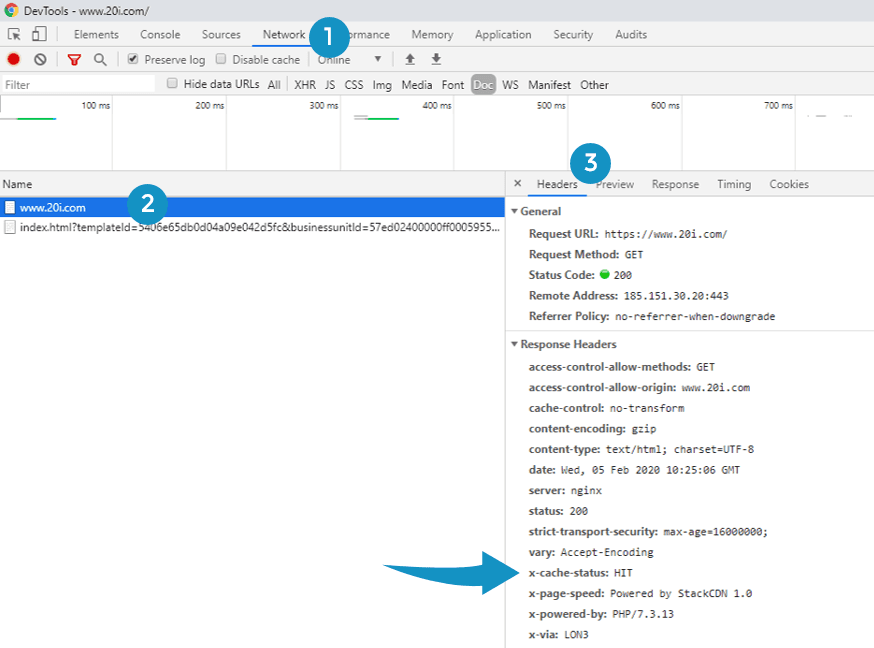What is 20i's CDN?
The 20iCDN is a powerful, free content distribution network (or content delivery network) that uses physical, highly optimised servers across the world to cache the content of your websites served from the 20i platform.
Cached content of the data is stored at multiple CDN nodes so global customers will connect directly to CDN nodes instead of directly to our local network, resulting in content being served faster and your websites loading quicker.
It's included for no extra charge with our Web Hosting, WordPress Hosting, Reseller Hosting, Autoscale Agency Hosting and Managed Hosting packages. The 20iCDN is comparable to paid plans from other CDN providers, like Cloudflare.
What are the benefits of a CDN?
- Content is actively cached: Every global CDN node actively caches static files. This offers an enhanced and consistent user experience to visitors everywhere - at the same time, page speed is improved and you'll deliver better-performing sites to your users.
- Latency is reduced: The 20iCDN has highly connected CDN nodes globally - this means your users will always reach a node close to them, reducing latency and improving website load times.
- Improved SEO: With the 20iCDN, you’ll get a Website Acceleration Suite which gives you the tools to help get your Google PageSpeed Score to 100/100. You’ll be able to select the One Click Optimisation section to add the recommended settings which should add the ideal, safe settings to improve website load times. Because page speed is a direct ranking factor for your websites ensuring these options are selected within the 20i control panel can help ensure your websites are optimised for SEO.
You can power-up your websites using the 20iCDN from within your My20i account. See the guide here for more information: How do I use 20i's CDN?
Understanding the 20iCDN
The CDN itself is used to cache static content. By default, the following file types are cached for 1 day before being purged automatically.
| bmp | class | css | csv |
| doc | docx | ejs | eot |
| eps | gif | ico | jar |
| jpeg | jpg | js | mid |
| midi | otf | pict | |
| pls | png | ppt | pptx |
| ps | svg | svgz | swf |
| tif | tiff | webp | woff |
| woff2 | xls | xls2 | robots.txt |
This type of cache is referred to as our Edge Caching as it's cached at our network edge (a.k.a the CDN nodes).
This cache can be purged at any time from the Edge Caching section within your control panel, this is accessed via Manage Hosting > Manage > Edge Caching.
Head down to the Purge Cache section to clear all the cached static content from all CDN nodes.
You can also change the amount of time Image, CSS and JavaScript cache is kept on our edge from the Edge Caching section or directly from within StackCache in the WordPress admin area.
What is Dynamic Cache?
Dynamic caching is when content that is generated dynamically on the website is cached. This can be content that is generated from scripts on the website.
A copy of that content is stored and is then served to subsequent users who request the same content until the cache expires. Our Dynamic Cache provides the ability to cache any resource like this at our edge by using public Cache-Control and Expires headers.
For websites using our StackCache plugin, this gives you full page dynamic content caching ensuring rapid TTFB times for all resources regardless of visitor location.
You can cache any other dynamic content using public Cache-Control and Expires headers via a .htaccess file - however, this is recommended only for advanced users only.
How to check your website is being cached
The easiest method to check that your site is being cached is to use Google Chrome's console to view your website's response HTTP headers.
In Google Chrome, follow the steps below:
- Using Chrome, visit your website, right-click and select Inspect to open the Developer Tools.
- Select the Network tab.
- Reload the website and the select any HTTP request from the left panel. The HTTP headers will be displayed in the right panel.

You'll be looking for the x-cdn-cache-status response to determine if the website has been cached. Please see the table below for the various responses you may see.
| HIT | The websites static content was requested from 20i's CDN. |
| MISS | The websites static content was not found in 20i's CDN and was loaded from the origin server. You'll see this on the first load of a website; subsequent reloads should show cache HIT. |
| BYPASS | The origin server instructed the 20iCDN to bypass cache. You'll see this if you're within the WordPress Admin - this ensures you'll always see the latest changes you make. |
Note: If you have other caching plugins such as W3 Total Cache or WP Super Cache these may interfere with the CDN and cause a cache MISS. These plugins can be disabled. For more information please see the guide here: Do I need caching plugins in addition to the 20i CDN?
